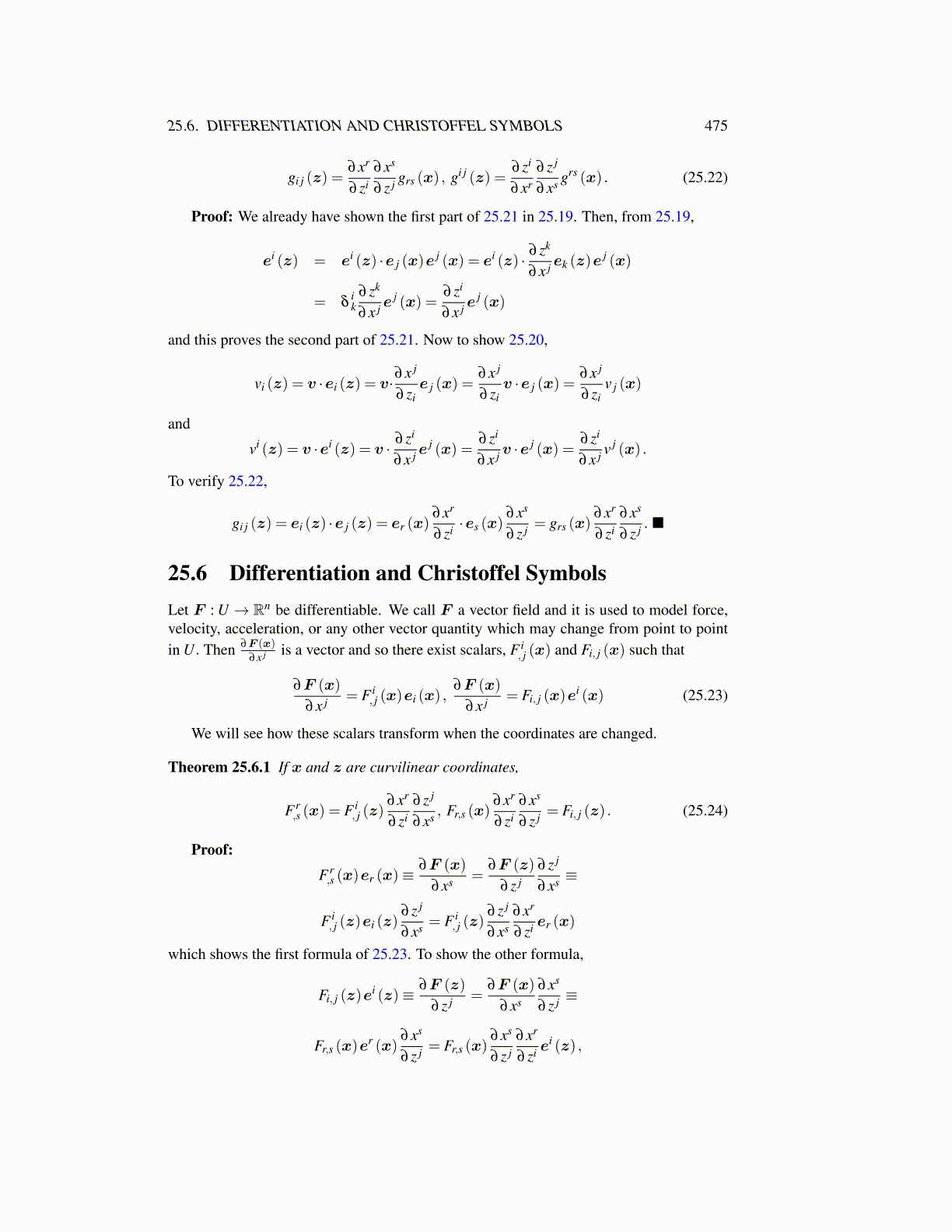
25.6. DIFFERENTIATION AND CHRISTOFFEL SYMBOLS 475
gi j (z) =∂xr
∂ zi∂xs
∂ z j grs (x) , gi j (z) =∂ zi
∂xr∂ z j
∂xs grs (x) . (25.22)
Proof: We already have shown the first part of 25.21 in 25.19. Then, from 25.19,
ei (z) = ei (z) ·e j (x)ej (x) = ei (z) · ∂ zk
∂x j ek (z)ej (x)
= δik
∂ zk
∂x j ej (x) =
∂ zi
∂x j ej (x)
and this proves the second part of 25.21. Now to show 25.20,
vi (z) = v ·ei (z) = v·∂x j
∂ zie j (x) =
∂x j
∂ ziv ·e j (x) =
∂x j
∂ ziv j (x)
and
vi (z) = v ·ei (z) = v · ∂ zi
∂x j ej (x) =
∂ zi
∂x j v ·ej (x) =
∂ zi
∂x j v j (x) .
To verify 25.22,
gi j (z) = ei (z) ·e j (z) = er (x)∂xr
∂ zi ·es (x)∂xs
∂ z j = grs (x)∂xr
∂ zi∂xs
∂ z j . ■
25.6 Differentiation and Christoffel SymbolsLet F : U → Rn be differentiable. We call F a vector field and it is used to model force,velocity, acceleration, or any other vector quantity which may change from point to pointin U. Then ∂F (x)
∂x j is a vector and so there exist scalars, F i, j (x) and Fi, j (x) such that
∂F (x)
∂x j = F i, j (x)ei (x) ,
∂F (x)
∂x j = Fi, j (x)ei (x) (25.23)
We will see how these scalars transform when the coordinates are changed.
Theorem 25.6.1 If x and z are curvilinear coordinates,
Fr,s (x) = F i
, j (z)∂xr
∂ zi∂ z j
∂xs , Fr,s (x)∂xr
∂ zi∂xs
∂ z j = Fi, j (z) . (25.24)
Proof:
Fr,s (x)er (x)≡
∂F (x)
∂xs =∂F (z)
∂ z j∂ z j
∂xs ≡
F i, j (z)ei (z)
∂ z j
∂xs = F i, j (z)
∂ z j
∂xs∂xr
∂ zi er (x)
which shows the first formula of 25.23. To show the other formula,
Fi, j (z)ei (z)≡ ∂F (z)
∂ z j =∂F (x)
∂xs∂xs
∂ z j ≡
Fr,s (x)er (x)
∂xs
∂ z j = Fr,s (x)∂xs
∂ z j∂xr
∂ zi ei (z) ,